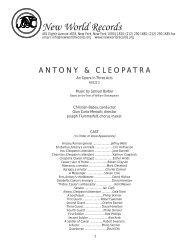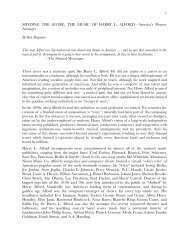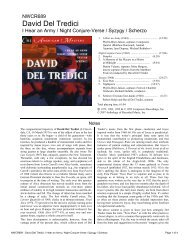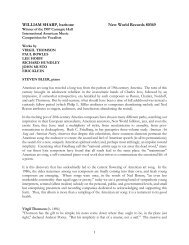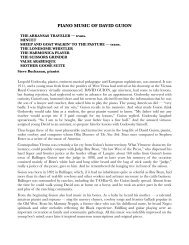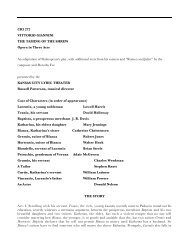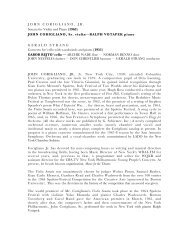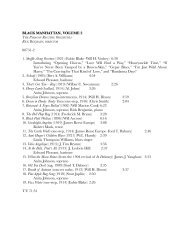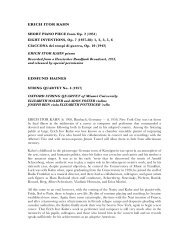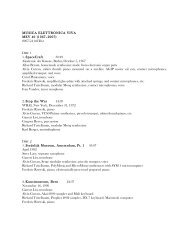THE SAN JUAN TURTLE DANCE - New World Records
THE SAN JUAN TURTLE DANCE - New World Records
THE SAN JUAN TURTLE DANCE - New World Records
You also want an ePaper? Increase the reach of your titles
YUMPU automatically turns print PDFs into web optimized ePapers that Google loves.
OKU SHAREH: <strong>TURTLE</strong> <strong>DANCE</strong> SONGS OF <strong>THE</strong> <strong>SAN</strong> <strong>JUAN</strong> PUEBLO<br />
<strong>New</strong> <strong>World</strong> <strong>Records</strong> 80301-2<br />
1. First Turtle Dance Song . . . . . . . . . 11:19<br />
2. Second Turtle Dance Song . . . . . . . .9:06<br />
3.Third Turtle Dance Song . . . . . . . . . .9:39<br />
4. Fourth Turtle Dance Song . . . . . . . . 9:41<br />
HERMAN AGOYO • CIPRIANO GARCIA • PETER GARCIA • ANTHONY<br />
S.ARCHULETA • JERRY GARCIA • STEVEN TRUJILLO<br />
<strong>THE</strong> <strong>SAN</strong> <strong>JUAN</strong> <strong>TURTLE</strong> <strong>DANCE</strong><br />
by Alfonso Ortiz<br />
ALFONSO ORTIZ is Professor of Anthropology at the University of <strong>New</strong> Mexico in Albuquerque He has<br />
written The Tewa <strong>World</strong> and has edited <strong>New</strong> Perspectives on the Pueblo. Dr. Ortiz was one of the program<br />
researchers and contributed to the liner notes for <strong>New</strong> <strong>World</strong> <strong>Records</strong> 80246-2: Songs of Earth,Water, Fire,<br />
and Sky<br />
The Pueblo of San Juan, from which these songs derive, is one of six Tewa-speaking<br />
villages located in north-central <strong>New</strong> Mexico along the Rio Grande and its tributaries.<br />
Gold-seeking early Spanish explorers applied the word "pueblo" ("town") to the Tewa,<br />
Tiwa, Towa, Keres, and Zuñi of <strong>New</strong> Mexico, as well as to the Hopi of Arizona, to<br />
distinguish these agricultural, town-dwelling Indians from their nomadic Apache, Navajo,<br />
and Plains neighbors.<br />
Although six distinct languages are spoken among the thirty-odd pueblos, which are<br />
spread over a rough 425-mile crescent from Taos in the northeast to Hopi in the<br />
northwest, the people are strikingly similar in their overall outlook and ways of life.<br />
There are nearly forty thousand Pueblo Indians, of whom more than four thousand are<br />
Tewa. San Juan is the largest of the Tewa pueblos, with a population of just under a<br />
thousand. It is also the most northerly of those pueblos reliant on the Rio Grande itself for<br />
irrigation and domestic water, located as it is just a few miles below where the great river<br />
bursts out of a narrow canyon.<br />
Until the end of the sixteenth century, some of the ancestors of the San Juan people lived<br />
on the west bank of the Rio Grande, directly across the river from present-day San Juan<br />
and very near the river's confluence with the Chama River, which emerges from the<br />
mountains a few miles to the northwest. The village on the west bank, which was called<br />
Place of the Mockingbirds, was first seen by European eyes when members of the<br />
Francisco Coronado expedition of 1540-41 visited it in their quest for plunder and for the<br />
fabled Seven Cities of Cibola. Indeed, every major Spanish expedition into <strong>New</strong> Mexico<br />
during the sixteenth century visited San Juan before turning back, away from the<br />
forbidding Black Mesa and the mountains to the north.<br />
The name San Juan was originally applied to this Tewa village by the Spanish adventurer<br />
and colonizer Juan de Oñate, who came in 1598 with a party of settlers and displaced the<br />
Tewa people at the Place of the Mockingbirds. In return for the Tewa's alleged hospitality
in yielding the village and cleared fields on the west bank to his colonizers, Oñate named<br />
the newly augmented village on the east bank San Juan de los Caballeros ("San Juan of<br />
the Gentlemen").To the people of San Juan and to other Tewa, the village is known as<br />
O'ke, a word of uncertain etymology, and the people are called O'ken. In any event, the<br />
people of the place the non-Tewa world calls San Juan live and farm on both sides of the<br />
Rio Grande, on a very beautiful and very fertile alluvial plain deposited by the two rivers<br />
just above the place where they converge. Mountains rise nearby in three directions. Only<br />
to the south does the country open up, as the valley originally made by the union of the<br />
two rivers begins to widen.<br />
The four songs recorded here accompany a religious dance performed annually in San<br />
Juan at the winter solstice. The Turtle Dance is easily the most important public religious<br />
ceremony of the San Juan calendar, defining as it does the end of one year and the<br />
beginning of a new one. The dance is named for the turtle, believed to be the first<br />
hibernating being that moves about after the year has turned; thus, the turtle is seen as<br />
symbolizing the beginning of each new annual cycle. Because the Turtle Dance and<br />
songs usher in a new year, the four songs must be composed anew for each year's<br />
performance. This is also true of those other dances and songs that usher in new seasons<br />
and their associated cycles of activity. For the majority of San Juan religious dances,<br />
however, the songs are unvarying, probably having been set for untold centuries.<br />
Each song should be performed four times in order to be regarded as completed: three<br />
times on as many plazas or dance areas within the village, and once more, in abbreviated<br />
form, within the kiva, or ceremonial chambers, into which the dancers retreat after each<br />
series of three public outdoor performances. The dancers, all men, line up in a long single<br />
row, shoulder to shoulder, each man clasping a gourd shell rattle and evergreen branches<br />
before him in his hands. On their right 2 knees the men wear rattles made of turtle shells<br />
with pigs' hooves attached to the tops by leather thongs. There are no other percussive<br />
instruments used, and there is no separate chorus as in many other Tewa dances. Rather,<br />
the dancers themselves form the chorus, with the most prominent singers, the composers<br />
of the songs, placed at the center of the line.<br />
What the Tewa people mean by "new" with regard to each year's edition of Turtle Dance<br />
songs is not to be understood in the literal English sense of the word. Rather, each year<br />
they recompose, from the corpus of their rich and timeless cultural heritage, songs that<br />
celebrate the old and the familiar in ever new ways. The same fundamental concerns are<br />
reflected each year in the songs, but always in new, fresh images. These traditional<br />
concerns are combined and recombined each year in seemingly inexhaustible<br />
permutations. Moreover, each song, whatever its specific content, always follows the<br />
same complex rhythm and structure. It does not matter which Turtle Dance song it is,<br />
from whatever year, nor does it matter how much or how little semantic content there is.<br />
The four songs here, for instance, vary in their semantically meaningful content, with the<br />
lexically retrievable—and hence translatable—diverging most sharply between the first<br />
and the last songs. Yet the structure and rhythm of the music remain largely the same; the<br />
first song merely has many more vocables than the last. Indeed, when song fragments or
even whole songs learned from non- Tewa Indians are incorporated into Turtle Dance<br />
songs, as they often are, there may be very little that is semantically meaningful to Tewa<br />
people in a given song. In any event, it is merely an accident of this particular year that<br />
the songs proceed from the semantically spare and simple in the first to the semantically<br />
most complex in the last; although songs will always differ in their semantic content,<br />
there need not be this kind of orderly progression from the simple to the complex.<br />
What are some of the enduring concerns the Tewa people express through these songs?<br />
Most are obvious in the poetic yet faithful renderings in the text. First, in their celebration<br />
of sons and daughters, of youthful dawn beings, of the dawning place, and of holy people<br />
of great vitality, the songs celebrate renewal and regeneration and the continuing process<br />
of creation. In their frequent mention of lakes, rainwater, fog rainbows, and mist cream,<br />
they express a concern for fertility. So, at the ends of songs and their dances, we often<br />
have the holy ones arriving joyously, with an abundance of corn, wheat, squash, and lifeimbuing<br />
powers. Similarly, there is a concern for joyousness, beauty, grace, and<br />
appropriate ritual behavior as pertaining to the sexes. Hence the youths, whether human<br />
or spiritual, sing, while the maidens, whether human or spiritual, make calls. This<br />
distinction hearkens back to a time when women responded to the singing of men with<br />
calls similar to the well-known tremolos of Plains Indian women.<br />
As well, there is a concern for ordering by directions, and for proceeding through the<br />
cardinal directions by means of a prescribed ritual circuit —(north-west-south-east)—as<br />
in the third song. Specific directions and their characteristic associations may also be<br />
celebrated, as is east in the second song and west in the fourth. Much more could be said<br />
of the symbolic content of the songs, but I should like to leave something for the listener<br />
and reader to discern for him- or herself. Perhaps the most subtle message of the songs,<br />
taken together, is that as long as they have their songs and dances, the San Juan people<br />
participate in an endlessly renewable dawn.This is why Tewa people who view this dance<br />
are reverently silent and attentive as they are for no other public dance of San Juan.<br />
<strong>SAN</strong> <strong>JUAN</strong> PUEBLO <strong>TURTLE</strong> <strong>DANCE</strong> SONGS— 1974<br />
Here at Dewy Water Structure, sacred village<br />
Here at Misty Corn Structure, sacred village Poseyemu's sons Poseyemu's daughters<br />
Gracefully are they shaking their rattles! Beautifully is there heard the sound of rattles!<br />
Here at Dewy Water Structure, sacred village<br />
Here at Misty Corn Structure, sacred village Poseyemu's sons Poseyemu's daughters<br />
Gracefully are they moving about as turtles! Beautifully are they dancing as turtles!<br />
Here at Dewy Water Structure, sacred village Here at Misty Corn Structure, sacred<br />
village<br />
Poseyemu youths have here come to look in on us, Bringing blessings of all kinds, rain!<br />
Poseyemu maidens have here been accepted!<br />
1<br />
2
Over there, at the Lake of the Dawn, Dawn Youths, their singing is heard!<br />
The beautiful singing of Dawn Youths is heard!<br />
Over there, at the Lake of the Dawn, Dawn Maidens are heard,<br />
Beautifully making their calls! Here at O'ke (San Juan) village<br />
There is raised an emergence kiva! A sacred kiva we do have!<br />
So that holy people may come to visit with us! Here at O'ke village<br />
There is raised an emergence kiva! A sacred kiva we do have!<br />
Here holy people have arrived to visit with us! Haya cham boo!<br />
Here at O'ke village There is raised an emergence kiva!<br />
Sacred doings we do have! Youths are singing beautifully!<br />
Beautiful are the songs which come from there! Haya cham boo!<br />
Here at O'ke village There is raised an emergence kiva!<br />
Sacred doings we do have! Maidens are making beautiful calls!<br />
Beautiful are the calls which come from there!<br />
Over there, at the Lake of the Dawn, Dawn Youths, their singing is heard!<br />
The beautiful singing of Dawn Youths is heard!<br />
Over there, at the Lake of the Dawn, Dawn Maidens are heard,<br />
Beautifully making their calls! Here at O'ke village<br />
There is raised an emergence kiva! A sacred kiva we do have!<br />
Sacred doings we do have! Away over there, at the dawning place,<br />
Dawn Youths are heard, singing beautifully! Away over there, at the dawning place,<br />
Dawn Maidens are heard, beautifully making their calls!<br />
Away to the north, holy people are gathering from every direction!<br />
They come, with their corn-growing powers, And still they come!<br />
Until here they have arrived! [loud rattling]<br />
Away to the west, holy people are gathering from every direction!<br />
They come, with their wheat-growing powers,<br />
And still they come!<br />
Until here they have arrived! [loud rattling]<br />
Away to the south, holy people are gathering from every direction!<br />
They come, with their squash-growing powers,<br />
And still they come!<br />
Until here they have arrived! [loud rattling]<br />
Away to the east, holy people are gathering from every direction!<br />
They come, with their power to raise all cultigens,<br />
And still they come! Until here they have arrived! [loud rattling]<br />
Away to the north, holy people are running about,<br />
Gathering from every direction!<br />
They come, with their rain-bearing powers,<br />
And still they come! Until here they arrive!<br />
Away to the west, holy people are running about,<br />
Gathering from every direction!<br />
3
They come, with their evergreens-and medicinal-plant-bearing powers,<br />
And still they come! Until here they arrive!<br />
Away to the south, holy people are running about,<br />
Gathering from every direction!<br />
They come, with their mist-cream and moisture-bearing powers,<br />
And still they come! Until here they arrive!<br />
Away to the east, holy people are running about,<br />
Gathering from every direction!<br />
They come, casting their fog rainbow toward us before them,<br />
And still they come! Until here they arrive!<br />
Away over there, at the dawning place, Dawn Youths are heard, singing beautifully!<br />
Away over there, at the dawning place, Dawn Maidens are heard, beautifully making<br />
their calls!<br />
4<br />
Over in the direction where the sun descends<br />
Deep, deep within the sacred lake<br />
From there the joyous singing<br />
Of holy people comes forth!<br />
Over in the direction where the sun descends<br />
Deep, deep within the sacred lake<br />
From there the joyous calls<br />
Of holy people come forth!<br />
Holy people are now emerging!<br />
Holy people are now coming!<br />
Holy people, with their corn-and wheat-raising powers, have arrived here!<br />
Holy people, with their clouds, rainwater, and fog rainbow cast before them, have arrived<br />
here! [rattle]<br />
Over in the west, in the place where the sun descends<br />
Way down deep, deep within the sacred lake<br />
From there the joyous singing<br />
Of holy people comes forth!<br />
Over in the west, in the place where the sun descends<br />
Way down deep, deep within the sacred lake<br />
From there the joyous calls<br />
Of holy people come forth!<br />
Holy people are now emerging!<br />
Holy people are now coming!<br />
Holy people, with their corn-and wheat-raising powers, have arrived here!<br />
Holy people, with their clouds, rainwater, and fog rainbow east before them, have arrived<br />
here! [rattle]<br />
Hapembe! Hapembe! Hapembe!<br />
Deep, deep, within the sacred lake<br />
From there the joyous singing<br />
Of holy people comes forth!
From there the joyous calls<br />
Of holy people come forth!<br />
Holy people are now emerging!<br />
Holy people are now coming!<br />
Holy people, with their singing and calling, have arrived here! [rattle]<br />
Away over there holy people emerge!<br />
Holy people are coming!<br />
Holy people, with their children-people- raising, with life-creating powers, have arrived<br />
here!<br />
Hapembe! Hapembe! Hapembe!<br />
Deep, deep within the sacred lake<br />
From there the joyous singing<br />
Of holy people comes forth!<br />
From there the joyous calls<br />
Of holy people come forth!<br />
Holy people are now emerging! Holy people are now coming!<br />
Holy people, with their singing and calling, have arrived here! [rattle]<br />
Over in the direction where the sun descends<br />
Deep, deep within the sacred lake<br />
From there the joyous singing<br />
Of holy people comes forth!<br />
Over in the direction where the sun descends<br />
Deep, deep within the sacred lake<br />
From there the joyous calls<br />
Of holy people come forth!<br />
Holy people are now emerging!<br />
Holy people are now coming!<br />
Holy people, with their corn-and wheat raising powers, have arrived here!<br />
Holy people, with their clouds, rainwater, and fog rainbow cast before them, have arrived<br />
here! [rattle]<br />
SELECTED BIBLIOGRAPHY<br />
Curtis,Edward S. (ed.) The North American Indian, Vol. XVII.<strong>New</strong> York: Johnson<br />
Reprint Corporation, 1970.<br />
Kurath, Gertrude P, with Garcia,Antonio F. Music and Dance of the Tewa Pueblos. No.<br />
8, Museum of <strong>New</strong> Mexico<br />
Research <strong>Records</strong> Sante Fe Museum of <strong>New</strong> Mexico Press, 1970.<br />
LaVigna, Maria. "Okushare, Music for a Winter Ceremony: The Turtle Dance Songs of<br />
San Juan Pueblo," Selected Reports<br />
in Ethnomusicology, Vol III, No 2. The Music of the American Indians. Edited<br />
by Charlotte Heth. Los Angeles: Program in Ethnomusicology, Dept. of Music,<br />
UCLA, 1979.<br />
Ortiz,Alfonso. The Tewa <strong>World</strong>: Space, Time, Being, and Becoming in a Pueblo Society.<br />
Chicago: University of Chicago<br />
Press, 1969.
Ortiz, Alfonso (ed.) Handbook of North American Indians,Vol. IX (one of two volumes<br />
on the Southwest).Washington,<br />
D.C.: Smithsonian Institution, 1979.<br />
________. <strong>New</strong> Perspectives on the Pueblos. Albuquerque: University of <strong>New</strong> Mexico<br />
Press, 1972. Parsons, Elsie Clews.<br />
Pueblo Indian Religion. 2 vols. Chicago: University of Chicago Press, 1939.<br />
________. The Social Organization of the Tewa of <strong>New</strong> Mexico. American<br />
Anthropological Association Memoir No 36,<br />
1929.<br />
Spinden, Herbert J. Songs of the Tewa. <strong>New</strong> York: The Exposition of Indian Tribal Arts,<br />
Inc, 1933.<br />
SELECTED DISCOGRAPHY<br />
Cloud Dance Songs of San Juan Pueblo. Indian House IH-1 102 (Taos, NM).<br />
Ditch Cleaning and Picnic Songs of Picuris Pueblo. Indian House IH-1051 (Taos, NM).<br />
Music of Picuris Pueblo, <strong>New</strong> Mexico.Taos Recordings and Publications TRP-121 (Taos,<br />
NM).<br />
Pueblo Indian Songs from San Juan. Canyon <strong>Records</strong> ARP-6065 (Phoenix,AZ).<br />
Songs of Earth, Fire,Water, and Sky.<strong>New</strong> <strong>World</strong> <strong>Records</strong> 80246-2 (<strong>New</strong> York, NY).<br />
Songs of Love, Luck, Animals, and Magic.<strong>New</strong> <strong>World</strong> <strong>Records</strong> 80297-2 (<strong>New</strong> York, NY)<br />
Turtle Dance Songs of San Juan Pueblo. Indian House IH-1001 (Taos, NM).<br />
Producer: Charlotte Heth<br />
Recording engineer: Michael Moore Recorded on location in San Juan Pueblo, <strong>New</strong><br />
Mexico<br />
Mastering: <strong>New</strong> York Digital Recording, Inc.<br />
Cover design: Bob Defrin<br />
Cover art: Turtle figurine. Polychrome ceramic. By Lela and Van Gtierrez, Santa Clara<br />
Pueblo.<br />
The four Turtle Dance song translations © 1979 by Alfonzo Ortiz<br />
This recording was made possible through grants from American Broadcast Companies;<br />
Armco Inc.; Capital Cities Communications; Dow Jones; Mr Francis Goelet; Gilman<br />
Foundation, Inc.; Occidental Petroleum Corporation; The Rockefeller Foundation; Sony<br />
Corporation; Union Pacific Corporation; and The <strong>New</strong> York State Council on the Arts.<br />
Charlotte Heth, a member of the Cherokee Nation of Oklahoma, is an Associate<br />
Professor of Music and Director of the American Indian Studies Center at UCLA. She<br />
has written and edited several articles, books, records, and videotapes on American<br />
Indian music. Ms. Heth has produced several recordings for <strong>New</strong> <strong>World</strong> <strong>Records</strong>:<br />
80246-2 Songs of Earth,Water, Fire and Sky: Music of the American Indian<br />
80297-2 Songs of Love, Luck,Animals, and Magic: Music of the Yurok and<br />
Tolowa Indians<br />
80301-2 Oku Shareh:Turtle Dance Songs of San Juan Pueblo
80337-2 Songs and Dances of the Eastern Indians from Medicine Spring and<br />
Allegany<br />
80343-2 Pow-wow Songs: Music of the Plains Indians<br />
80406-2 Navajo Songs From Canyon De Chelly<br />
FOR NEW WORLD RECORDS:<br />
Herman E. Krawitz, President; Paul Marotta, Managing Director; Paul M. Tai, Director of<br />
Artists and Repertory; Lisa Kahlden, Director of Information Technology; Virginia<br />
Hayward, Administrative Associate; Mojisola Oké, Bookkeeper<br />
RECORDED ANTHOLOGY OF AMERICAN MUSIC, INC., BOARD OF TRUSTEES:<br />
Francis Goelet, Chairman; David Hamilton, Treasurer; Milton Babbitt; Emanuel Gerard;<br />
Adolph Green; Rita Hauser; Herman E. Krawitz; Arthur Moorhead; Elizabeth Ostrow; Don<br />
Roberts; Patrick Smith; Frank Stanton.<br />
NO PART OF THIS RECORDING MAY BE COPIED OR REPRODUCED<br />
WITHOUT WRITTEN PERMISSION OF R.A.A.M., INC.<br />
NEW WORLD RECORDS<br />
16 Penn Plaza #835<br />
NEW YORK, NY 10001-1820<br />
TEL 212.290-1680 FAX 212.290-1685<br />
Website: www.newworldrecords.org<br />
email: info@newworldrecords.org<br />
LINER NOTES Recorded Anthology of American Music, Inc.



